As a content creator for streetsounds.net, I’m always on the lookout for compelling solo wargames. The appeal of these strategic board games, where you pit your wits against a game system acting as the opponent, has only grown over time. I’ve even curated lists of my favorite solo titles and favorite solitaire game series, reflecting my passion for this genre.
Last year, I discovered and thoroughly enjoyed Stalingrad: Advance to the Volga, 1942. Its simple rules combined with surprising depth and high replay value immediately captivated me. Naturally, exploring its sequel became a priority.
About the Game: Navigating the Savage Streets
Manila: The Savage Streets, 1945, designed by Michael Rinella and published by Revolution Games/Take Aim Designs, places you in command of the American forces during the intense battle for Manila. The game system cleverly manages the Japanese defenders, who are largely static but fiercely determined. Each turn presents fresh challenges – random events, uncertain supply lines, and concealed Japanese strengths and tactics.
The core game is a nine-turn campaign that vividly recreates the American offensive in February and March 1945. As American troops push deeper into Manila, from the less defended outskirts to the urban core and heavily fortified government buildings, Japanese resistance intensifies. The attrition of American units becomes a critical factor as they are worn down in the brutal street-to-street fighting.
Manila: The Savage Streets, 1945 boasts a quick and variable setup for each playthrough. Several optional rules add layers of complexity and realism, significantly increasing the challenge. For history enthusiasts, the game is rich in historical context, enhancing the immersive experience.
Session Report: Into the Savage Streets of Manila
One of the best ways to grasp the nuances of a game is through repeated plays in close succession. This allows you to immediately apply lessons learned from previous sessions. Before writing this review, I immersed myself in several games of Manila: The Savage Streets. Using one of these sessions as an example, I want to share a closer look at the gameplay, accompanied by images to showcase the game’s impressive components.
Historical Background: Manila, once known as “the Pearl of the Orient,” fell under Japanese occupation in January 1942. By 1945, it was a sprawling city of 800,000, a major hub in Southeast Asia. Declared an open city by retreating American forces in 1941 to avoid destruction, Manila was now the target of General Douglas MacArthur’s determined liberation campaign upon his return to the Philippines. Pre-war, MacArthur himself resided in the iconic Manila Hotel (Area 37), a key objective in the game.
Victory Conditions: An Automatic American Victory is achieved if, at the end of any Combat Phase, every area on the map is under American control. Conversely, a Japanese Automatic Victory occurs if American Morale reaches “0” at the end of any Combat Phase.
An Operational Victory for the Americans is declared if, by the start of the End Phase of Turn 9 (the final turn), they control Intramuros (Area 37) and the “American Control” markers on the Record Track total 34 or more. This mirrors the historical outcome.
PS. Click on any image below to view a larger version in a new window.
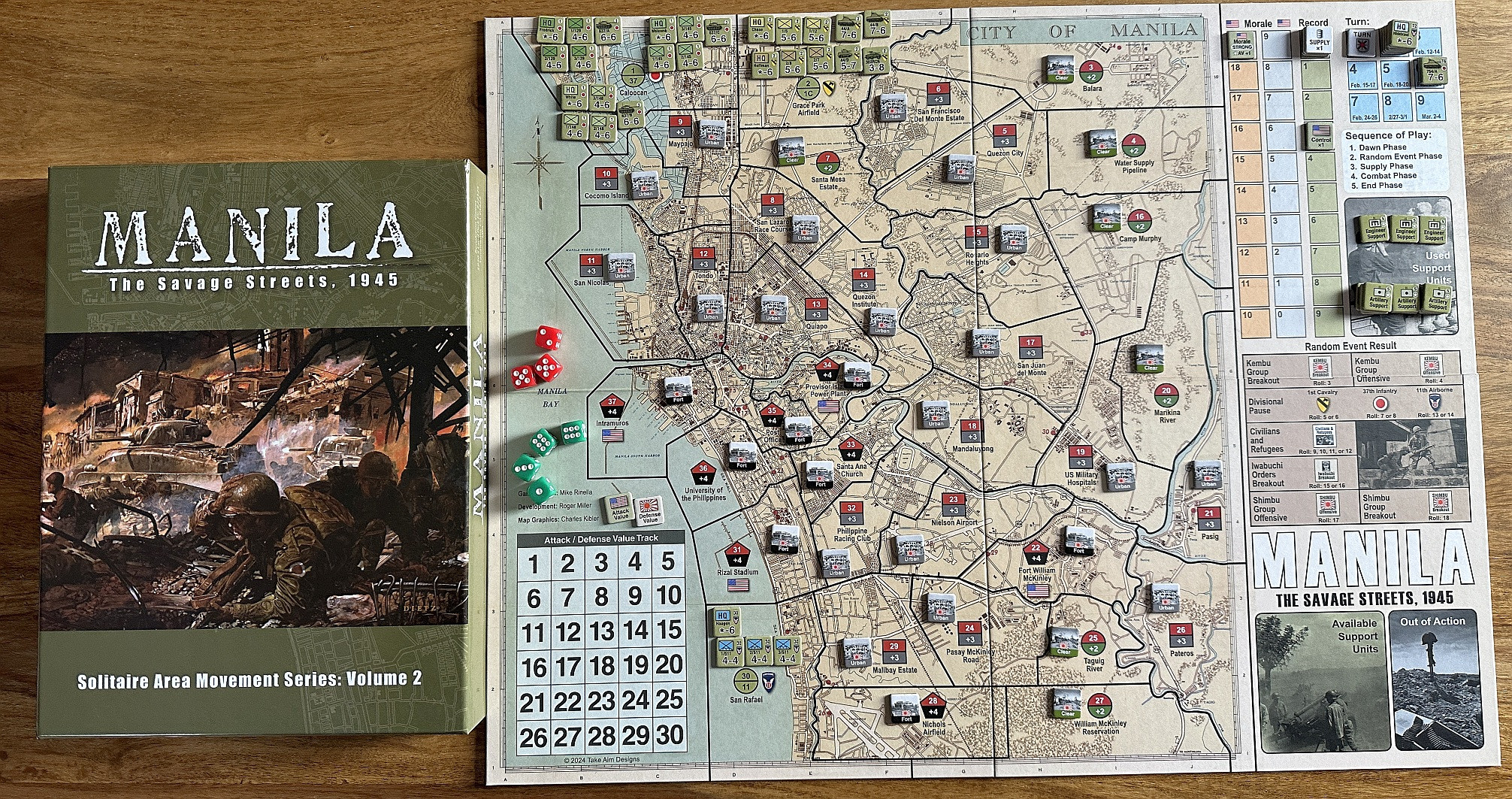 Manila: The Savage Streets, 1945 game setup showcasing counters, reinforcements, and initial unit deployments.
Manila: The Savage Streets, 1945 game setup showcasing counters, reinforcements, and initial unit deployments.
 American 37th Infantry and 1st Cavalry Divisions poised to spearhead the assault through Manila's northern suburbs and urban areas.
American 37th Infantry and 1st Cavalry Divisions poised to spearhead the assault through Manila's northern suburbs and urban areas.
 The 11th Airborne Division launching an attack from the south near San Rafael, aiming to create a pincer movement against Japanese defenders.
The 11th Airborne Division launching an attack from the south near San Rafael, aiming to create a pincer movement against Japanese defenders.
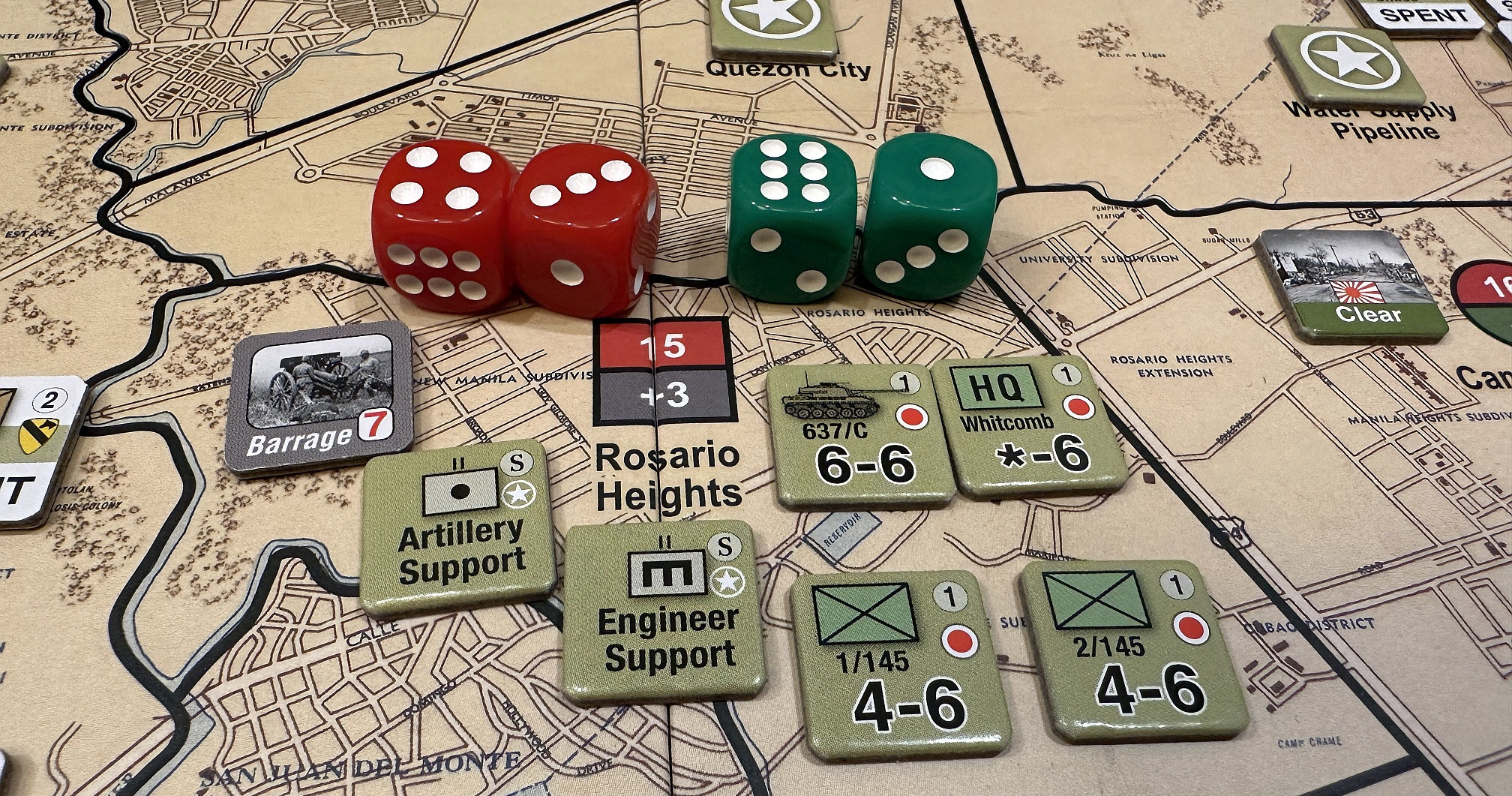 Entering a new Manila area in Savage Streets; even with division-level strength, engineer support, and artillery, success is not guaranteed, and morale can quickly decline with setbacks.
Entering a new Manila area in Savage Streets; even with division-level strength, engineer support, and artillery, success is not guaranteed, and morale can quickly decline with setbacks.
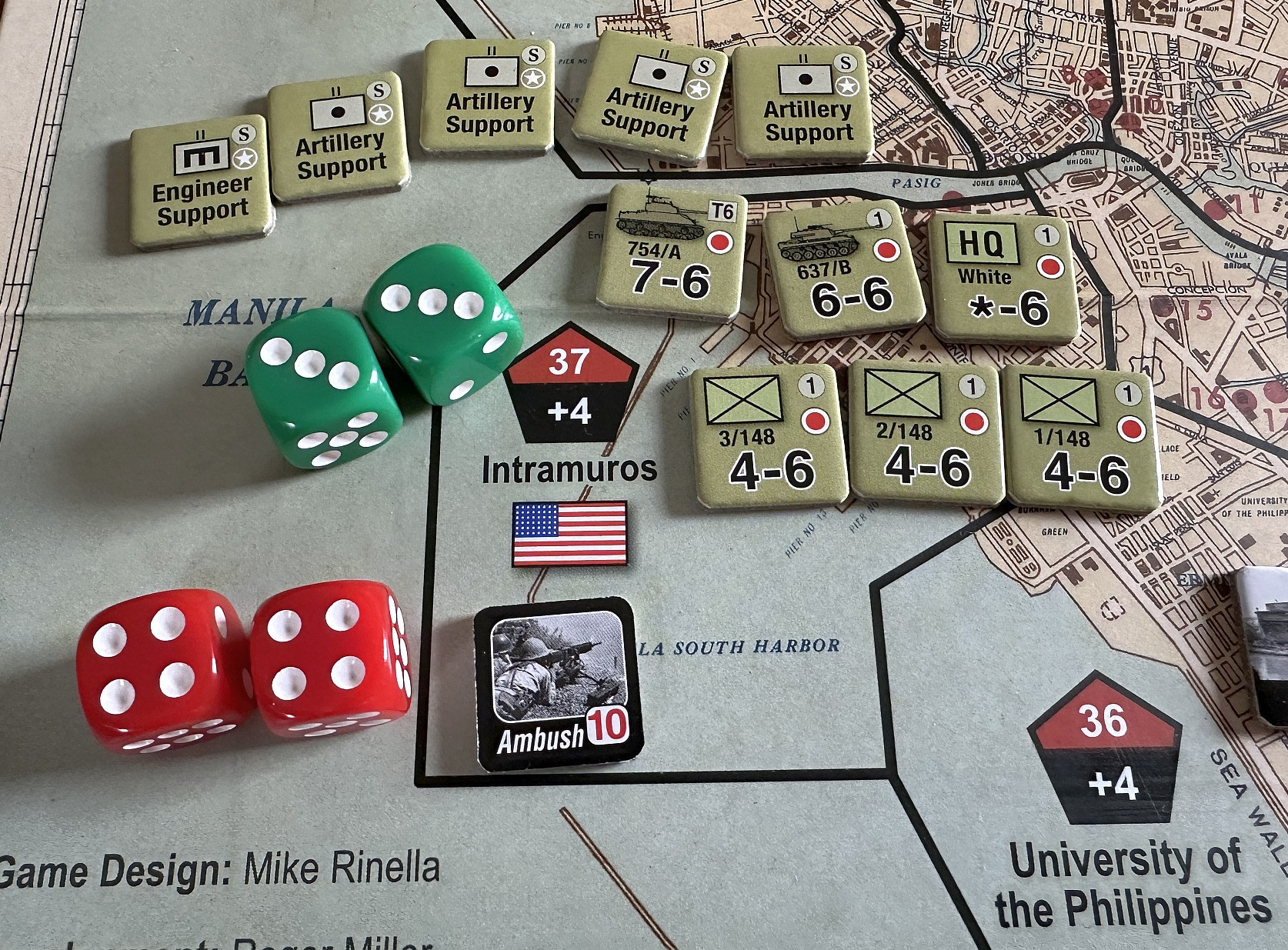 Fierce combat in fortified Japanese positions during the Manila Savage Streets battle; Intramuros eventually falls after intense fighting against significant enemy forces.
Fierce combat in fortified Japanese positions during the Manila Savage Streets battle; Intramuros eventually falls after intense fighting against significant enemy forces.
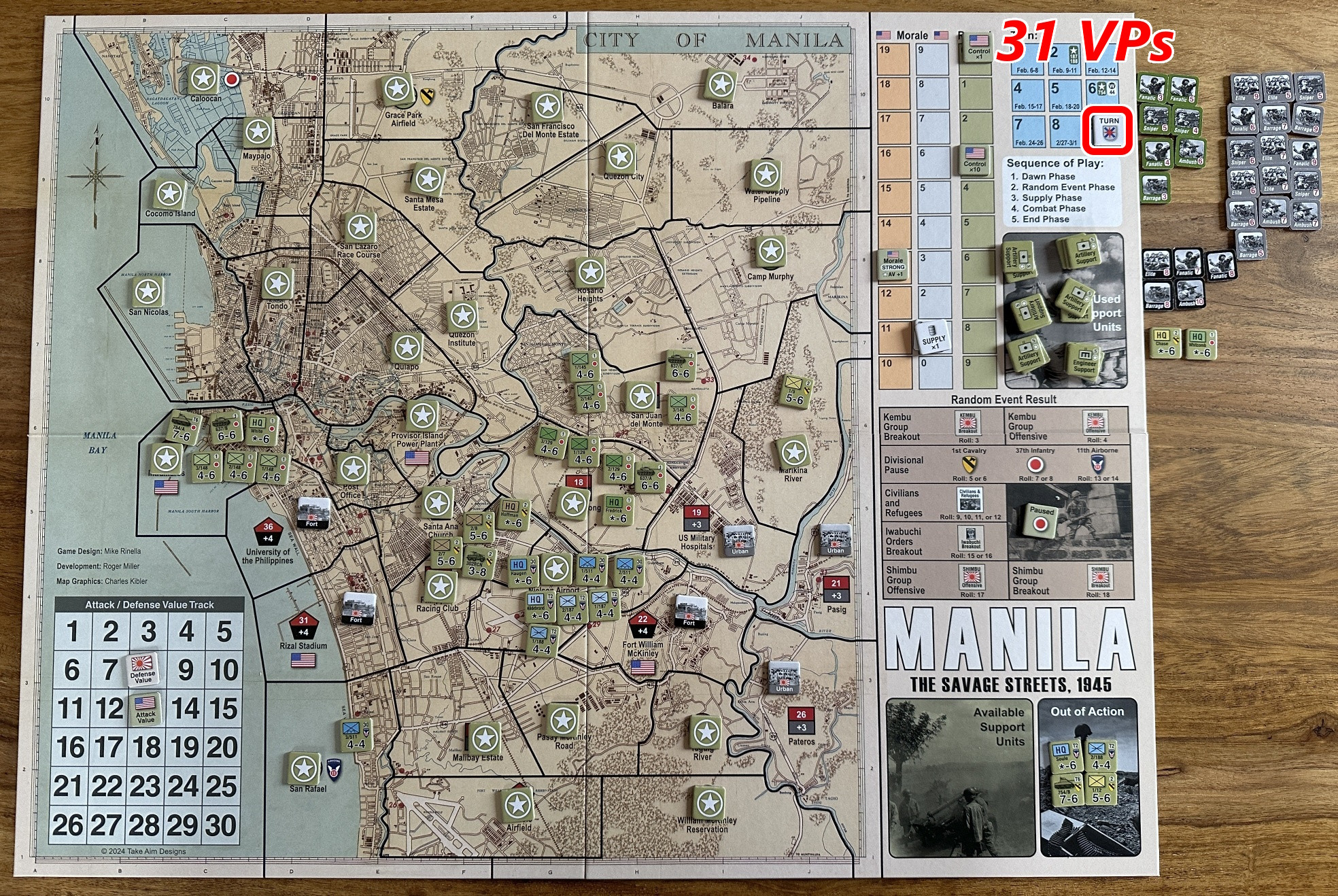 End of a full game scenario in Savage Streets of Manila; nine turns of intense combat result in 31 victory points, a narrow defeat but a highly engaging solo wargame experience.
End of a full game scenario in Savage Streets of Manila; nine turns of intense combat result in 31 victory points, a narrow defeat but a highly engaging solo wargame experience.
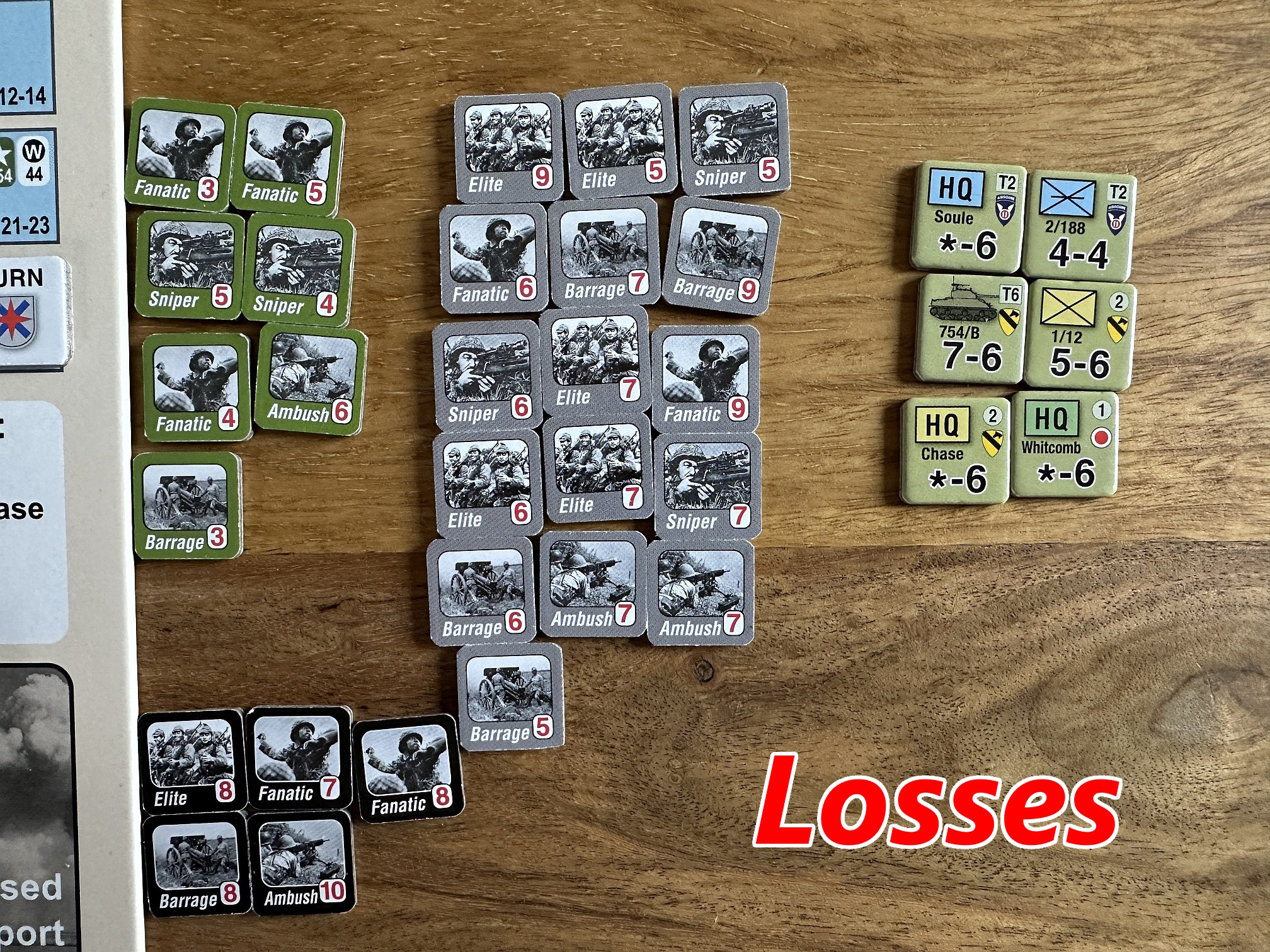 Comparative losses for both American and Japanese forces in Savage Streets of Manila, illustrating how terrain significantly influences combat intensity and tactical approaches.
Comparative losses for both American and Japanese forces in Savage Streets of Manila, illustrating how terrain significantly influences combat intensity and tactical approaches.
First Impressions: Surviving the Savage Streets
After several playthroughs of Manila: The Savage Streets, my impressions are overwhelmingly positive. Here are some key takeaways:
-
Challenging AI: For solo wargames, a robust and challenging AI is crucial. Manila delivers precisely that. Despite the Japanese forces being primarily defensive, they present a formidable obstacle. The game consistently triggers that “one more try” impulse, pushing you to refine your strategies and tactics.
-
Dynamic Defense: Building upon Stalingrad, Manila subtly elevates the defender’s role. Be prepared for unexpected Japanese counter-attacks, adding a layer of unpredictability and strategic depth beyond static defense lines.
-
Meaningful Optional Rules: The optional rules in Manila: The Savage Streets aren’t mere afterthoughts. They genuinely enhance realism and difficulty, while also giving specialized units like Engineers a more prominent role. Experimenting with these rules is highly recommended for experienced players seeking an even greater challenge.
-
Component Quality: The production quality of Manila is exceptional. The board, styled like a WWII-era map, the detailed counters, the glossy rulebook, and even the included dice – all contribute to a premium feel and enhance the overall gaming experience from an aesthetic perspective.
-
Strategic Randomness Management: While dice rolls are frequent, Manila isn’t about pure luck. Supply management, artillery barrages, engineer support, and air power provide tools to mitigate randomness and ensure success where it matters most. Strategic prioritization of these resources is key, shifting focus from chance to calculated decisions.
-
Single Scenario Focus: Unlike Stalingrad with its two scenarios, Manila: The Savage Streets features only one main campaign scenario. While historically focused, additional scenarios would extend the game’s lifespan and offer diverse gameplay experiences.
-
Replayability Considerations: While Japanese deployments are randomized within terrain types, creating varied resistance each game, the overall campaign structure remains consistent. Starting from the same entry points and often pursuing similar avenues of advance might lead to a sense of repetition over many plays. Again, a second scenario would significantly boost long-term replayability.
Conclusion: Conquering the Savage Streets
Overall, Manila: The Savage Streets, 1945 has left a very positive impression. It’s a well-designed sequel to Stalingrad, offering a compelling and often tense solo wargaming experience. While challenging and sometimes frustrating, particularly when facing entrenched defenses, the game is ultimately rewarding and enjoyable. Highly recommended for solo wargame enthusiasts, and excitingly, the next game in the series is on the horizon, promising even more Savage Streets to conquer.
